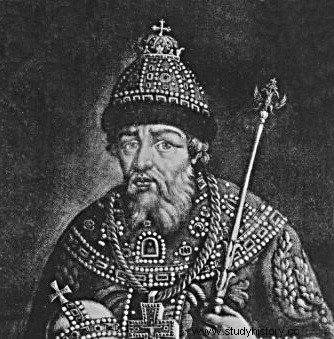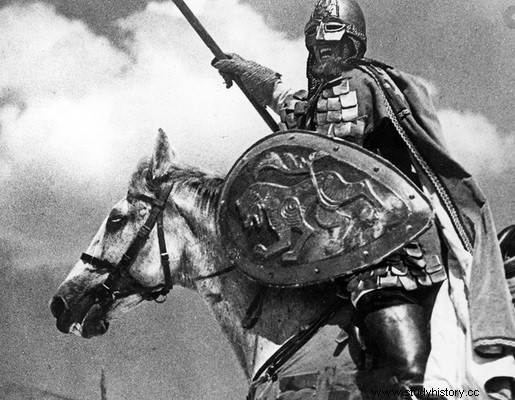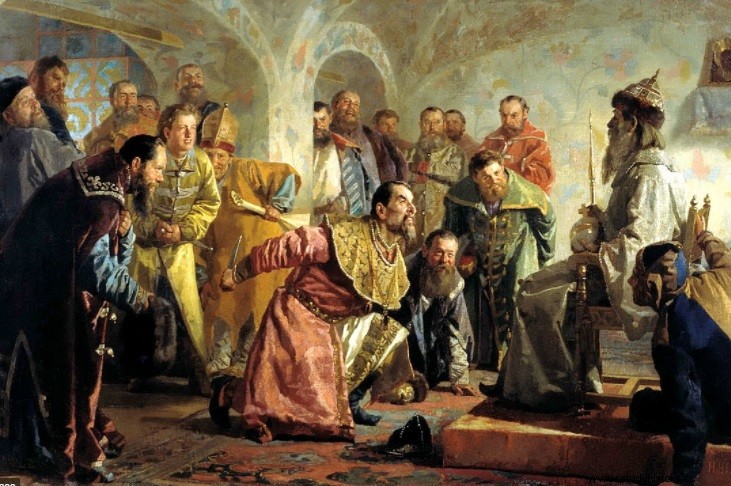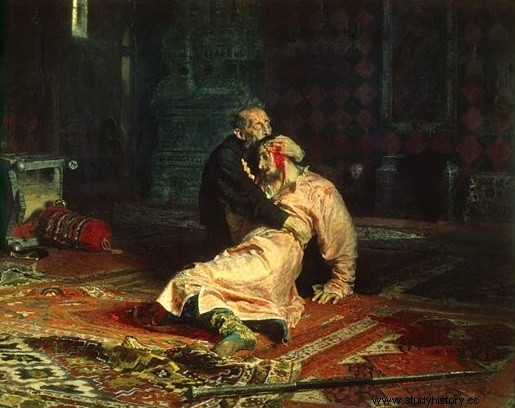 Ivan IV the Terrible (1530-1584), Grand Prince of Moscow and Tsar of Russia is one of the founders of the Russian state. He is one of the most famous Russian sovereigns in the West along with Pierre Le Grand, Catherine II and Nicolas II. If the latter are known for their reforms or for their disastrous fate in the case of the last Romanov, Ivan The Terrible evokes a violent reign but ultimately quite obscure for the general public. Indeed, Ivan's reign after 1560 is better known for the whimsical behavior and wanton brutality he repeatedly displayed than for his political skill. The Russian tyrant was immortalized in the cinema in a famous film by Sergei Eisenstein (1942-1946).
Ivan IV the Terrible (1530-1584), Grand Prince of Moscow and Tsar of Russia is one of the founders of the Russian state. He is one of the most famous Russian sovereigns in the West along with Pierre Le Grand, Catherine II and Nicolas II. If the latter are known for their reforms or for their disastrous fate in the case of the last Romanov, Ivan The Terrible evokes a violent reign but ultimately quite obscure for the general public. Indeed, Ivan's reign after 1560 is better known for the whimsical behavior and wanton brutality he repeatedly displayed than for his political skill. The Russian tyrant was immortalized in the cinema in a famous film by Sergei Eisenstein (1942-1946).
Ivan the Terrible's Childhood
The "long-awaited" son of Vasily III (1479-1533) and Helena Glinska, Ivan experienced court violence very early on. Born on August 25, 1530, he ascended the throne three years later on the death of his father. A first crisis arises to know how the regency will be ensured. His mother pulls out of the game and manages to assert herself until her death in 1538, probably due to poisoning. A government of boyars then took power and although Ivan describes this time in a negative light, he was a precursor of his reforms.
From this period, certain problematic traits of his personality emerge:he orders various executions from 1543 and seeks to inspire fear. He exercises, according to Prince Kourbski, cruel acts on animals. He would also have asked on September 3, 1545 that the language of a person be cut because he would have pronounced an impolite word. This spiral of violence ended in 1547, according to Kourbski, following the burning of Moscow. His good education and piety allow Ivan to take on the role of the good (albeit terrible) tsar who respects God and the clergy.
A glorious and hopeful start to the reign
The first important event in the reign of Ivan the Terrible was his coronation, which transformed the great principality into a universal empire, heir to the Eastern Roman Empire. He was then proclaimed tsar January 16, 1547. He even managed to obtain in 1557 the blessing of the Patriarch of Constantinople. Kourbsky indicates that the Tsar had during the first part a "Chosen Council" composed of wise and competent men (the Metropolitan of Moscow Macarius, the priest Sylvester, Alexei Adachev and perhaps Kourbsky himself!). They reportedly tempered Ivan's outbursts just like Empress Anastasia Romanovna Zakharin. The government is implementing a series of important reforms in the judiciary, local administration, religion and the military.
 But the regime was weakened in 1553 by the illness of Ivan IV and the death of the first Tsarevich Dimitri. The greatest territorial advances, almost unexpected, took place at the beginning of his reign:the annexation of Kazan by arms in 1552 and of Astrakhan in 1556 opened Russia towards Asia and the Russians crossed the borders for the first time of the Rous'. The great principality is definitely transformed into a multi-confessional empire.
But the regime was weakened in 1553 by the illness of Ivan IV and the death of the first Tsarevich Dimitri. The greatest territorial advances, almost unexpected, took place at the beginning of his reign:the annexation of Kazan by arms in 1552 and of Astrakhan in 1556 opened Russia towards Asia and the Russians crossed the borders for the first time of the Rous'. The great principality is definitely transformed into a multi-confessional empire.
The Livonian War also begins during this period. Ivan successfully invaded the region in 1558. At the same time, a second front was opened against the Crimean Tatars. Although Ivan tried to lead the two conflicts at the same time, he was forced to withdraw and cease the offensives, especially as the situation at court deteriorated.
Ivan the Terrible and the Terror
The second part of the reign is much less glorious. Following the death of his first wife in 1560 (certainly due to poisoning) and military setbacks, the Tsar began to see the betrayal around him and had more and more people executed. This is accentuated by the loss of advisers from the beginning of the reign according to some. From 1564 a rather original system was set up following a staged and calculated abdication:the oprichnina. Muscovy is divided between the zemchtchina, where the rules of administration do not change, and the oprichnina, a kind of "reserve" under the direct authority of Ivan.
 This division did not happen by chance and the territories kept by Ivan have considerable importance and purposes specific policies (uprooting of old families, control of key economic areas and regions close to borders, etc.). It is accompanied by the creation of the oprichniki, very violent riders dressed like monks, responsible for maintaining order by all means in the oprichnina.
This division did not happen by chance and the territories kept by Ivan have considerable importance and purposes specific policies (uprooting of old families, control of key economic areas and regions close to borders, etc.). It is accompanied by the creation of the oprichniki, very violent riders dressed like monks, responsible for maintaining order by all means in the oprichnina.
All of these measures allow an unprecedented renewal of Russian actors. The legal or summary repression is considerable. This system is motivated by revenge against traitors but also by his desire to leave the world (in a monastic ideal). His absences are real but temporary. He can now exercise repression as he sees fit.
It is in this context that the conflict between Metropolitan Philip and the Tsar took place after his refusal to bless the sovereign in 1568 ended in the strangulation of the religious l 'Next year. The year 1570 seems to be the terrible apogee of the oprichnina with the capture of the city of Novgorod (and the looting of Tver on the way), accused of treason just like its archbishop Pimen. Novgorod is plundered and many people are killed. But at the same time, however, a new act of the reign of Ivan IV is in preparation.
A difficult end of reign
At the same time, some think that we have gone too far and purges within the oprichnina are made. From the trial of the Archbishop of Novgorod, some oprichniki are associated with the conspiracy and are executed. Members of the old aristocracy are coming back into favor and have key positions. He tries to rectify the situation on the military and diplomatic level. In 1571, the Crimean Tatars again invaded Russia and burned Moscow. At the same time, Livonia is in turmoil.
The year 1572 is an important turning point in the reign of Ivan IV:with the defeat of the Crimean Tatars in the Battle of Molodi and the end of the oprichnina, Russia emerging from a critical political situation. The conflicts with the Western countries do not cease even if for the latter there is no longer any question of destroying the Russian Empire in spite of the military reverses which this one undergoes. Peace is signed in 1582 with Poland and is not so unfavorable as what one could write for the Russians. In 1583, another treaty was ratified with Sweden. Territorial gains ultimately turn out to be negative on the Western Front.
 Tatar raids really stop only during the last years of Ivan's reign. The conquest of the East progresses towards Siberia. The country emerges very weakened from past events and from the famines and epidemics that periodically plague it. The interior reforms resume on the ecclesiastical and noble possessions. Many exceptional tax levies on the clergy as well as on the Muscovy Company are decreed.
Tatar raids really stop only during the last years of Ivan's reign. The conquest of the East progresses towards Siberia. The country emerges very weakened from past events and from the famines and epidemics that periodically plague it. The interior reforms resume on the ecclesiastical and noble possessions. Many exceptional tax levies on the clergy as well as on the Muscovy Company are decreed.
The death of the heir and posterity of Ivan the Terrible
In 1581 a new tragedy took place:Ivan IV killed his son following a dispute between the two men. This death marked him indisputably:he no longer wore anything but black and gave alms. He even makes a kind of partial aggiornamento of the oprichnina by the measures he takes to reconcile himself with the nobility and the servants through the Obituary, his political testament.
During this period, the rules of departure for serfs are less respected, which leads to a strengthening of serfdom. This was necessary due to the state the empire is in and for the reconciliation between the monarchy and the nobility. Ivan IV the Terrible died on March 18, 1584 after taking the habit of a monk, thus reconnecting with the family tradition.
Bibliography
- Ivan the Terrible, biography of Henri Troyat. Flammarion, 2007.
- Ivan the Terrible or the Trade of Tyrant, by Pierre Gonneau. Tallandier, March 2014.
